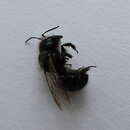en
names in breadcrumbs


Osmia ribifloris is a little black bee with a shiny dark green abdomen, slightly smaller than a honey bee.It is one of about three hundred species in the genus known as the mason bees (Osmia), and its subgenus of about twenty closely related species is found throughout the holarctic.This megachilid bee is a solitary bee native to North America.Instead of forming a hive with a queen, individual females lay up to 36 eggs in hollow tubes in reeds or abandoned boring insect holes during a six week period in the spring between mid-March and mid-May. Females make a linear series of chambers, one for each of their eggs, starting at the far end of the tube, placing a morsel of pollen and nectar down, laying their egg on top, sealing the space with mud or masticated plants, and then repeating the process until they have filled the tube. When the eggs hatch after about a week, the larvae eat the pollen left for them, mature into a pupa and then into an adult, all within their chamber over the course of the summer.They overwinter as dormant adults in their cell (Muller 2013; Anderson 1998; Rust 1986).
Osmia ribifloris bees are docile, do not sting readily and are excellent pollinators since they collect more pollen than nectar. Unlike other closely related mason bees, O. ribifloris have a far less generalist flower visitation strategy, pollinate only a few species of flowers, a trait useful in ensuring that those particular plant species cross-pollinate (Anderson 1998; Muller 2013). O. ribifloris has been developed as a commercial blueberry pollinator, and it is estimated that one female bee contributes to about $25 of blueberry production and pollinates about eight blueberry flowers per minute.Many extension programs and garden centers promote advice and services to help individual gardeners to support and breed Osmia and other solitary bees, especially as honeybee populations have declined precipitously since (Bambara 2002; Anderson 1998; Torchio 1990; Sampson et al. 2004, 2013; vanEngelsdorp et al 2009).
Osmia ribifloris, one of several species referred to as a blueberry bee, is a megachilid bee native to western North America, including Oregon, California, Nevada, Utah, Arizona, New Mexico, Texas and northern Mexico. This solitary bee normally gathers pollen from plants in the family Ericaceae, with manzanita, Arctostaphylos sp. being a preferred host in the wild. It will pollinate blueberries, and is sometimes used commercially for this purpose.[1]
Osmia ribifloris, one of several species referred to as a blueberry bee, is a megachilid bee native to western North America, including Oregon, California, Nevada, Utah, Arizona, New Mexico, Texas and northern Mexico. This solitary bee normally gathers pollen from plants in the family Ericaceae, with manzanita, Arctostaphylos sp. being a preferred host in the wild. It will pollinate blueberries, and is sometimes used commercially for this purpose.